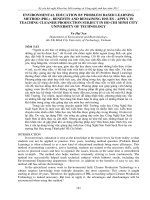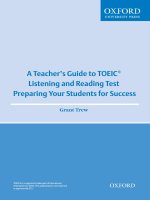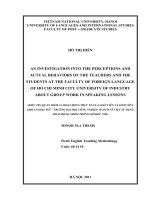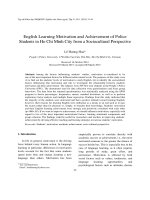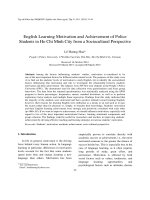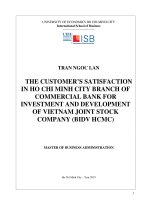Designing supplementary toeic listening and reading test preparation syllabus for pre intermediate level students in ho chi minh city university of natural resources and evrironment a thesis submitted in partial fulfil
Bạn đang xem bản rút gọn của tài liệu. Xem và tải ngay bản đầy đủ của tài liệu tại đây (36.53 MB, 207 trang )
MINISTRY OF EDUCATION AND TRAINING
HO CHI MINH CITY OPEN UNIVERSITY
------
DESIGNING SUPPLEMENTARY
TOEIC-LISTENING AND READING
TEST PREPARATION SYLLABUS FOR
PRE-INTERMEDIATE LEVEL STUDENTS
IN HO CHI MINH CITY UNIVERSITY OF
NATURAL RESOURCES AND ENVIRONMENT
Major: Teaching English to Speakers of Other Language (TESOL)
Major code: 60 14 01 11
MASTER OF ARTS IN TESOL
Supervisor: Ph.D. HUYNH CONG MINH HUNG
- Ho Chi Minh City, 2019 -
TRƯỜNG ĐẠI HỌC MỞ
CỘNG HÒA XÃ HỘI CHỦ NGHĨA VIỆT NAM
THÀNH PHỐ HỒ CHÍ MINH
Độc lập – Tự do – Hạnh phúc
KHOA ĐÀO TẠO SAU ĐẠI HỌC
GIẤY XÁC NHẬN
Tôi tên là:
Nguyễn Lương Tuấn Dũng
Ngày sinh:
14/08/1985
Chuyên ngành: MTESOL
Nơi sinh:
TP. Vinh, Nghệ An
Mã học viên: 1581401110007
Tơi đồng ý cung cấp tồn văn thông tin luận án/ luận văn tốt nghiệp hợp lệ về bản
quyền cho Thư viện trường đại học Mở Thành phố Hồ Chí Minh. Thư viện trường
đại học Mở Thành phố Hồ Chí Minh sẽ kết nối tồn văn thơng tin luận án/ luận văn
tốt nghiệp vào hệ thống thông tin khoa học của Sở Khoa học và Công nghệ Thành
phố Hồ Chí Minh.
Ký tên
(Ghi rõ họ và tên)
…………………………………
i
STATEMENT OF AUTHORSHIP
I hereby declare that I am the sole author of this master thesis “Designing
supplementary TOEIC Listening and Reading test preparation syllabus for pre-intermediate
level students in Ho Chi Minh City University of Natural Resources and Environment”
I certify that the thesis is my original work; it is based on my own research. All
sources used by me have been documented and I have not used any sources other than those
listed in the bibliography and identified as references. No other person’s work has been used
without due acknowledgement.
I further declare that I have not submitted this thesis at any other institution in order to
obtain a degree.
Author’s Signature………………………………………………………
Nguyen Luong Tuan Dung
Ho Chi Minh City, Date………………………………
ii
ACKNOWLEDGEMENT
I would first like to express my deepest appreciation to my thesis advisor Ph.D. Huynh
Cong Minh Hung. The door to Ph.D. Huynh Cong Minh Hung’s office was always open
whenever I ran into a trouble spot or had a question about my research or writing. He
consistently allowed this paper to be my own work, but steered me in the right the direction
whenever he thought I needed it.
I would also like to thank the students at the Ho Chi Minh City University of Natural
Resources and Environment, who were involved in the questionnaire for this thesis. Without
their passionate participation and input, the validation questionnaire could not have been
successfully conducted.
Besides, I would like to acknowledge M.A. Lai Hoai Chau of the Faculty of Basic
Sciences at the Ho Chi Minh City University of Natural Resources and Environment as the
second reader of this thesis, and I am gratefully indebted to her for her very valuable comments
on this thesis.
In addition, I would like to give a big thank to my friends, my classmates, and my
colleagues for their support, assistant, and encouragement in studying, in work, and in the
process of doing the thesis.
Finally, I must express my very profound gratitude to my parents and to my spouse, as
well as my beloved son for providing me with unfailing support and continuous encouragement
throughout my years of study and through the process of researching and writing this thesis.
This accomplishment would not have been possible without them.
Thank you and wish you all the best.
Author
Nguyen Luong Tuan Dung
iii
Abstract
As recognizing the importance of TOEIC certificate as a good tool to assess people’s
English competence before entering labor workforce, Ho Chi Minh University of Natural
Resources and Environment has been implemented TOEIC in curriculum as an obligatory
subject since 2015. However, the limitation of time (90 periods) and big class size
organization prevented students to get the qualified band score of 500 to get the approval for
graduation. To fulfil the knowledge gap and gain the crucial skills in doing the test, students
of pre intermediate level are encouraged to attend a supplementary course which lasts in 96
periods. This course provides more terminology vocabulary of TOEIC, revising important
grammatical points, guiding students with skills to overcome the traps in the newest format
test. Despite those clear aims, up to now there has been no official guide or syllabus for the
course, letting the course run by the experiences of different teachers without united content
of lessons or goals to achieve at the end of each period.
From the requirement of such teaching situation, the author of this thesis is motivated
to carry out a research to suggest a sample syllabus for the supplementary course. To
complete the goal, a survey of learners’ needs would be preceded, providing crucial statistics
about what are the strengths and weaknesses of learners as well as their expectations for
teachers and for the course. Further, the analysis of the TOEIC test samples in new format
would also be taken into consideration to help author have a deeper understanding of what
skills are required to spend time on. Combing all those information, a sample syllabus is
suggested for the supplementary program for pre-intermediate students. This syllabus
supported as an oriented guide for teachers with the name of the core books and the content
needed to cover in each lesson. It is aslo helpful for students who want to prepare well for the
course and review after the lessons.
Keywords: TOEIC test, Reading and Listening skills, syllabus design, learners’ need,
task analysis
iv
TÓM TẮT
Nhận biết được tầm quan trọng của việc sử dụng TOEIC như một cơng cụ đánh giá
trình độ tiếng Anh trong thị trường lao động, trường Đại học Tài Ngun và Mơi trường
thành phố Hồ Chí Minh đã sớm đưa nội dung luyện thi TOEIC vào Chương trình giảng dạy
chính khóa từ năm 2015. Tuy nhiên, những hạn chế về thời gian học trên lớp (90 tiết) cũng
như việc tổ chức lớp học đông sinh viên đã mang lại khơng ít những khó khăn cho sinh viên
để đạt được mức điểm TOEIC như mong muốn. Thưc tế đó đã đặt ra yêu cầu cần có một
khóa học bổ trợ để giúp sinh viên không những bổ sung những kiến thức còn thiếu hụt về từ
vựng và ngữ pháp, mà còn thu thập và luyện rèn những kỹ năng, chiến thuật cần thiết trong
quá trình làm bài thi TOEIC. Tuy nhiên, cho tới thời điểm hiện tại vẫn chưa có một chương
trình giảng dạy chính thức nào cho khóa học này, khiến cho các tiết học chủ yếu dựa vào
kinh nghiệm của giáo viên.
Do đó, mục đích chính của luận văn này là cung cấp một Chương trình giảng dạy
mẫu cho khóa học bổ trợ Luyện thi TOEIC. Nhờ đó, giáo viên có thể tham khảo và vận dụng
để thiết kế bài giảng của từng cá nhân, nhằm đáp ứng mục tiêu, yêu cầu giảng dạy, cũng như
trên hết là dìu dắt sinh viên đạt được điểm số TOEIC như mong muốn.
Để thiết kế được chương trình giảng dạy phù hợp, bảng câu hỏi điều tra về nhu cầu
người học được thiết kế và sử dụng nhằm giúp cung cấp cho người nghiên cứu một bức tranh
toàn cảnh về điểm mạnh, điểm yếu cũng như là những điều mong đợi từ khóa học của sinh
viên. Ngồi ra, việc phân tích những yêu cầu, những điểm khó, những bẫy của từng phần
trong các đề thi TOEIC vừa được cập nhật cũng được tiến hành một cách nghiêm túc và cẩn
thận, chi tiết, nhằm cung cấp cho người học hiểu biết sâu sắc về bài thi TOEIC và hình dung
được những chiến thuật nào họ cần tập trung ôn luyện trước khi tham gia kỳ thi.
Sau khi thu thập các nguồn thông tin cần thiết, luận văn đã đi đến việc đề xuất một
Chương trình giảng dạy bổ trợ mẫu Luyện thi TOEIC kỹ năng nghe và đọc cho sinh viên
v
khơng chun ngữ, trình độ Tiền Trung cấp về tiếng Anh của trường Đại học Tài Nguyên và
Môi trường thành phố Hồ Chí Minh. Chương trình này mong muốn trở thành một ngọn hải
đăng định hướng cho tất cả giáo viên và sinh viên đang đồng hành trên những con thuyền
trong biển tri thức của nhân loại, cùng nhau dạy và học nhằm đến đạt kết quả cao trong bài
thi TOEIC.
Từ khóa: TOEIC, kỹ năng nghe và đọc, thiết kế chương trình giảng dạy, nhu cầu người học,
phân tích nhiệm vụ.
vi
Table of Contents
STATEMENT OF AUTHORSHIP .............................................................................. i
ACKNOWLEDGEMENT ......................................................................................... ii
Abstract................................................................................................................... iii
Table of Contents...................................................................................................... vi
List of Figures .......................................................................................................... ix
List of Tables ............................................................................................................. x
List of Abbreviations ................................................................................................ xi
CHAPTER 1: INTRODUCTION .............................................................................. 1
1.1.
Statement of problem ................................................................................. 1
1.2.
Purpose of the research............................................................................... 3
1.3.
Research questions (RQ) ............................................................................ 3
1.4.
Significance of the study ............................................................................ 3
1.5.
Thesis structure .......................................................................................... 4
1.6.
Chapter summary ....................................................................................... 5
CHAPTER 2: LITERATURE REVIEW .................................................................... 6
2.1.
Syllabus and syllabus types ........................................................................ 6
2.1.1. The definitions and nature of syllabus .................................................... 6
2.1.2. Types of syllabus ................................................................................... 7
2.1.3. Syllabus design ...................................................................................... 9
2.1.4. Needs analysis ..................................................................................... 10
2.1.5. Selection of syllabus content ................................................................ 12
2.1.6. Syllabus organization ........................................................................... 12
2.2.
The TOEIC - Listening and Reading Test ................................................. 13
2.3.
Listening and Reading skills ..................................................................... 16
2.3.1. Listening ............................................................................................. 16
2.3.2. Reading ............................................................................................... 18
2.4.
Related studies and research gaps ............................................................. 21
2.5.
Chapter summary ..................................................................................... 23
CHAPTER 3: METHODOLOGY............................................................................ 25
3.1.
Background .............................................................................................. 25
3.2.
Sample and sampling method ................................................................... 26
3.3.
Research design ....................................................................................... 26
vii
3.4.
Instruments .............................................................................................. 28
3.4.1. Description of the Questionnaire .......................................................... 28
3.4.2. Reliability and Validity of the Questionnaire ........................................ 29
3.4.3. The way of analyzing questionnaire ..................................................... 32
3.4.4. Task analysis ........................................................................................ 33
3.5.
Chapter summary ..................................................................................... 34
CHAPTER 4: RESULTS AND DISCUSSION ........................................................ 35
4.1.
Results and discussion on the RQ1 ........................................................... 35
4.1.1. Results of leaners’ need analysis .......................................................... 35
4.1.2. Discussion on the RQ1 ........................................................................ 44
4.2.
Results and discussion on the RQ2 ........................................................... 46
4.2.1. Results of task analysis ........................................................................ 46
4.2.2. Discussion on the RQ2: ....................................................................... 78
4.3.
Results and discussion on the RQ3 ........................................................... 82
4.3.1. Results of questionnaire on leaners’ need analysis ................................ 82
4.3.2. The supplementary TOEIC Listening and Reading test preparation
syllabus
..…………………………………………………………………………88
4.3.3. SAMPLE LESSON PLAN .................................................................. 98
4.3.4. Discussion on the RQ3 ...................................................................... 105
4.4.
Chapter summary ................................................................................... 106
CHAPTER 5: CONCLUSIONS............................................................................. 107
5.1.
Conclusions ........................................................................................... 107
5.2.
Limitations of the study .......................................................................... 107
5.3.
Applications and Recommendations ....................................................... 108
5.4.
Suggestions for further research .............................................................. 111
5.5.
Chapter summary .................................................................................... 112
References ............................................................................................................. 113
APPENDICES....................................................................................................... 120
Appendix A.1. THE QUESTIONNAIRE (English Version) ............................... 120
Appendix A.2. THE QUESTIONNAIRE (Vietnamese Version) ......................... 125
Appendix A.3. CRONBACH’S ALPHA OF THE QUESTIONNAIRE .............. 131
A.3.1. Items 3.1-3.5: Students’ English-learning experiences ............................. 131
A.3.2. Items 4-7: Student’s TOEIC experiences ................................................. 131
A.3.3. Items 11-18: Evaluation of students’ Reading skills ................................. 131
viii
A.3.4. Items 19-26: Evaluation of students’ Listening skills ............................... 132
A.3.5. Items 27-29: TOEIC studying materials................................................... 132
A.3.6. Items 32-34: TOEIC study methods......................................................... 133
Appendix B.1. TEST SPECIFICATION ............................................................ 134
Appendix B.2. TOEIC – LISTENING AND READING PERCENTILE RANK
TABLE ......................................................................................................................... 136
Appendix B.3. THE INSTRUCTIONAL MATERIALS ..................................... 137
Primary materials: .......................................................................................... 137
Supplemental materials .................................................................................. 138
Appendix B.4. A SAMPLE SHORT CONVERSATION OF TOEIC LISTENING PART 4 ......................................................................................................................... 141
Appendix B.5. HANDOUTS AND PRACTICE ................................................. 142
Practice 1: Organization recognition exercise ................................................. 142
Practice 2: Jumbled sentences: rearrange the following sentences into reasonable
order for introductions ............................................................................................... 142
Practice 3: VOCABULARY: match the words with their definitions .............. 143
Practice 4: Listen to the cut sections of the introduction, guess what will come
next.
………………………………………………………………………………....143
Practice 5: Mini Test practice: Listen and answer the following questions ...... 144
Appendix B.6. EVALUATION ON INSTRUCTIONAL MATERIALS .............. 146
B.6.1. Evaluation on Primary materials .......................................................... 146
B.6.2. Brief evaluation on the selection of supplemental materials ................. 152
Appendix C. THE TOEIC BOOKS FOR TASK ANALYSIS ............................. 155
ix
List of Figures
Figure 4-1. The effect of basic English to TOEIC score ................................................... 38
Figure 4-2. Listening – Part 1: Directions ........................................................................ 47
Figure 4-3. Listening – Part 1: Example .......................................................................... 47
Figure 4-4. Types of Distractors in Listening - Part 1 ...................................................... 48
Figure 4-5. Listening – Part 1: Example of distractors .................................................... 49
Figure 4-6. Listening – Part 2: Directions ........................................................................ 51
Figure 4-7. Types of Questions in Listening - Part 2 ........................................................ 52
Figure 4-8. Types of Distractors in Listening - Part 2 ...................................................... 54
Figure 4-9. Types of WH-Questions in Listening - Part 2 ................................................ 56
Figure 4-10. Listening – Part 3: Directions ...................................................................... 57
Figure 4-11. Listening – Part 4: Directions ...................................................................... 62
Figure 4-12. Sub-types of Specific Information Questions in Listening - Part 4 ............ 64
Figure 4-13. Types of Questions in Reading - Part 5 ........................................................ 67
Figure 4-14. Types of Vocabulary Questions in Reading - Part 5 .................................... 69
Figure 4-15. Types of Grammar Questions in Reading - Part 5 ...................................... 69
Figure 4-16. Types of Vocabulary Questions in Reading - Part 6 .................................... 73
Figure 4-17. Types of Grammar Questions in Reading - Part 6 ...................................... 73
Figure 4-18. Types of Single Passages in Reading - Part 7 ............................................... 75
Figure 4-19. Types of Questions in Reading - Part 7 ........................................................ 76
Figure 4-20. The necessity of using TOEIC supplementary documents.......................... 83
Figure 4-21. Choice of TOEIC materials for test preparation......................................... 84
Figure 4-22. Ways of using TOEIC supplementary documentary. .................................. 85
Figure 4-23. Course load and portions ............................................................................. 85
Figure 4-24. The time apportion for each skill ................................................................. 85
Figure 4-25. Effective methodologies in practice for the test ........................................... 86
Figure 4-26. Students’ expectation of TOEIC score ......................................................... 87
x
List of Tables
Table 2-1: Updated TOEIC – Listening and Reading in comparison to the old TOEIC 14
Table 3-2. Research methodology in relation to the RQs ................................................. 27
Table 3-3. Reliability of Evaluation of students’ Reading skills – Cronbach’s Alpha of
Items 11 to 18 ..................................................................................................................... 30
Table 3-4. Reliability of Evaluation of students’ Listening skills – Cronbach’s Alpha of
Items 19 to 26 .................................................................................................................... 31
Table 4-5. Students’ self-evaluation of their English listening skills ................................ 35
Table 4-6. Students’ experience of the most difficult skill in TOEIC .............................. 36
Table 4-7. The importance of TOEIC to students ............................................................ 37
Table 4-8. The importance of TOEIC to students’ job ..................................................... 37
Table 4-9. Evaluation of students’ Reading skills ............................................................. 38
Table 4-10. Evaluation of students’ Listening skills ......................................................... 41
Table 4-11. Types of Distractors in Listening - Part 1 ...................................................... 48
Table 4-12. Statistics on types of questions in TOEIC – listening – Part 2...................... 53
Table 4-13. Statistics on types of distractors in TOEIC – listening – Part 2 ................... 55
Table 4-14 Statistics on types of Questions in Listening - Part 3 ..................................... 58
Table 4-15. Statistics on types of Questions in Listening - Part 4 .................................... 63
Table 4-16. Statistics on types of Talks in Listening - Part 4 ........................................... 65
Table 4-17. Statistics on Types of Questions in Reading – Part 5 .................................... 70
Table 4-18. How many hours should I study for the TOEIC test? .................................. 88
Table 4-19. Number of Periods for each Part of the TOEIC Test .................................... 95
Table 4-20. Contents of the supplementary TOEIC Listening and Reading test
preparation syllabus .......................................................................................................... 96
Table 4-21. Contents of the Sample Lesson Plan ............................................................ 100
xi
List of Abbreviations
Adj
Adjective
Adv
Adverb
ETS
ESL
Educational Testing Service
English as a Second Language
ELT
English Language Teaching
fig.
figure
FLC
Foreign Language Center
F
Frequency
HCMUNRE
Ho Chi Minh city University of Natural Resources and Environment
IELTS
International English Language Testing System
LC
Listening comprehension
M
Mean
N
Noun
P
Percent
RC
Reading comprehension
RQ
research question
S.D
Standard Deviation
SPSS
Statistical Package for the Social Sciences
TESOL
Teaching English as a Second Language
TOEIC
Test of English for International Communication
TOEFL
Test Of English as a Foreign Language
V
Verb
1
CHAPTER 1: INTRODUCTION
1.1. Statement of problem
It is the process of globalization emphasizing the necessity of communicating and
working in international network that makes more and more companies in Vietnam ask for
international certificate like Test of English for International Communication (TOEIC),
International English Language Testing System (IELTS), Test Of English as a Foreign
Language (TOEFL) to their applicants. As a result, universities, where resources of future
labor force are trained with crucial skills, are keeping up with the trend by requesting their
students to study for the tests. Not standing out of the factual situation, Ho Chi Minh
University of Natural Resources and Environment (HCMUNRE) has implemented the
TOEIC program as a compulsory subject and a must condition for graduating.
Due to the assigned curriculum, students have two stages of TOEIC preparation,
which can improve theirs scores from 200 to 350 after 90 periods of class-meetings.
Meanwhile, the requirement for graduating is set at 450 TOEIC, turning the gap of about 100
marks (350 to 450) now becomes the self-study program of students. They should be
provided more with vocabulary, revised grammatical points and prepared with tips to deal
with the actual tests. In HCMUNRE, the Foreign Language Center (FLC) is the unit who is in
charge of holding supplementary classes to complement this students’ lack. They had already
hold some classes with the purpose of “practicing for TOEIC” which lasts for 90 periods.
However, the center has not been come up with any clear program recently. There is no
official guide for syllabus design for this English program, which leave teachers the full
rights to decide what and how to teach basing on the allocated time. Hence, this is a chance
for 12 teachers in English faculty to show their creativity, but at the same time, turns out a big
2
challenge for them. It is urgent for the birth of a syllabus which clearly defines the goals, the
books, the skills need achieving after each lessons.
Another matter should be paid attention is the changes in TOEIC format since June
2019. The new format may confuse their examinees by adding more complicated questions in
both Reading and Listening part, which are totally new even to experienced teachers. The
numbers of books and supplementary document in the market, for that reason, has still been
quite limited, providing little help for teachers and students in their preparation for the tests.
As a result, with the connecting to specific objectives and guideline, it is hoped that the
suggested syllabus could help not only teachers in knowing what to teach but also for
students to support best for their self-study procedure as the time in class is limited.
Furthermore, listening test which counts for half of the TOEIC test is a skill that has
not been taught much in high school. Most of students did not get familiar with listening in
general and TOEIC Listening test in specific. Thus, being provided with the lists of skills
necessary for the test would make students more focused on their aims and have a better
orientation of what they should strike for.
With all those facts, the author had a great motivation to carry out this research as a
crucial part of teaching job. These papers, as a part of the effort to completing the
curriculums for the Department, attempt to analyze the needs of students toward TOEIC
learning, together with some suggestions for the syllabus, which later can be used officially in
FLC of the university. By analyzing the learners’ needs, teachers would recognize the
importance point to focus on during teaching process. The birth of a sample syllabus with
specific content is requisite to guide them in choosing suitable activities for their teaching.
Moreover, the research also play a key role in adding more view for the banks of TOEIC
research as it will look at the new format test with changes applied in Vietnam from June
2019.
3
1.2. Purpose of the research
With all these above reasons, these papers are written with the aim of understanding
more about students’ desire, base on which to suggest a suitable syllabus for pre-intermediate
learners. Hence, the three clear purposes of these papers should be stated are:
- To analyze the learner’s needs of studying Supplementary TOEIC – Listening and
Reading preparation course at the HCMUNRE.
- To find out which subordinate skills of listening and reading that the updated TOEIC
tests requires test-takers.
- To suggest a suitable syllabus with clear objectives and content for improving
Listening and Reading skills for TOEIC at the HCMUNRE.
1.3. Research questions (RQ)
To achieve the above aims, the following research questions are raised:
RQ 1. What are the learners’ needs about the Supplementary TOEIC – Listening and
Reading preparation course at the HCMUNRE?
RQ 2. Which subordinate skills the updated TOEIC tests requires test-takers?
RQ 3. What is the suggested syllabus for Supplementary TOEIC – Listening and
Reading preparation course at the HCMUNRE?
1.4. Significance of the study
This thesis adds an unfilled part about the researches of TOEIC as it takes the new
format of TOEIC into consideration. As mentioned above, this new format has just been
applied in Vitenam since June 2019, brings a lot of new changes that the learners and
reasearchers have not grasped with a careful consideration. The analysis of the tasks from the
newest released sample tests would shorten the gaps of knowledge of test takers, takes them
closer to the actual tests and equip them with crucial skills after changing. The banks of
4
researches relating to TOEIC, TOEIC format and TOEIC teaching, thus, would be more
completed.
Another expected contribution of the thesis is the suggested syllabus could complete
its role as a the guide for the teachers and students to base on to know clearly what to focus
and what needs to gain, bringing better results after all for the course. This benefits the
administrators in FLC in following the teaching procedures and assessing students. It is
hoped that the suggested syllabus could be applied for a long term development of classes in
FLC at HCMUNRE.
1.5. Thesis structure
The thesis consists of five chapters
Chapter 1: Introduction
This first chapter presents the readers with an overview of the research: the reasons
for carrying out, the goals, and meaning of the study.
Chapter 2: Literature review
The chapter gives an overview of the past researches about the related terms in topic,
including syllabus, TOEIC, learners’ need analysis, listening and reading skills as well as
states the research gaps.
Chapter 3: Methodology
The chapter gives information about research procedure including: what research
scope is, what methodology is chosen to fulfill the research purposes, and which tool to be
used to collect and analyze the necessary data
Chapter 4: Results and discussion
This is the most important chapter of the thesis which provided the specific answers
for the research questions.
Chapter 5: Conclusions
5
The last chapter of the thesis makes conclusions of the three research problems,
evaluates the limitations of the research, as well as provides implications and
recommendations for teaching and learning in test preparation classrooms.
1.6. Chapter summary
In short, it is the necessity in meeting the demand of studying process that the
supplementary course has been introduced in HCMUNRE with the willing of providing
students clear view of the test and specific skills to achieve high band score. This first chapter
presents the readers with an overview of the research: the reasons for carrying out, the goals,
and meaning of the study. The readers would find reasonable ideas and good orientation for
the following part of data collection and data analysis.
6
CHAPTER 2: LITERATURE REVIEW
The chapter gives an overview of the past researches about the related terms in topic,
including syllabus, TOEIC, learners’ need analysis, listening and reading skills as well as
states the research gaps.
2.1. Syllabus and syllabus types
2.1.1. The definitions and nature of syllabus
Curriculum, together with syllabus has long been among the core terms in teaching. In
Allen’s point, curriculum is a general concept which involves consideration of the whole
complex of philosophical, social and administrative factors which contribute to the planning
of an educational program (Allen, 1984: 61). Candlin (1984: 31) thought that curriculum
includes language studying contents, studying process, experience, evaluation, and the role
relationships of the teachers and learners. Getting to smaller terms, syllabus is a sub-part
happening in class basing on given curriculum, which is concerned with a specification of
what units will be taught. Widdowson (1984:26) considered syllabus as a framework of
activities as well as a teaching device to facilitate learning. To its simplest meaning, syllabus
is a material telling teachers and learners what issue should be focused on and how much
time for it (Hutchinson and Waters, 1987). This traditional interpretation of syllabus
concentrated on outcomes rather than process. In a more complicated way of view, Yalden
(1987: 87) thought of syllabus as a "summary of the content to which learners will be
exposed", which can replace the concept “method” and through it, teachers can acquire the
relevance between the needs and aims of the learner and the activities which will take place
in the class room. As this way seems to be more concise than the former one, this core notion
of defining the syllabus will used as the basis to design the syllabus in thesis.
7
Consider the important of designing syllabus, Nunan (1988) defined curriculum
planning as the decision making process, which including: identifying leaners’ needs and
purposes; establishing goals and objectives; selecting and grading content; organizing
appropriate learning arrangements and learner grouping; selecting, adapting or developing
appropriate materials, learning tasks; and assessment and evaluation tools as well.
Accordingly, syllabus is a statement of contents which is used as the basis for planning
courses of various kinds and the task of syllabus designer is to select and grade this content.
Different linguistics offered various ways of creating a syllabus depending on the various
approaches that the designers would like to focus on. It depends on the various approaches
that the designers would like to focus on. So far, syllabi have been organized basing on
structures (Ellis, 1997) notions (Finocchiaro & Brumfit 1983) skills (Johnson, 1996), tasks
(Long & Crookes, 1993) and some other factors.
In short, curriculum is a broader notion concerned with the planning, implementation,
evaluation, management, and administration of education programmes whilst syllabus centers
narrowly on the selection and grading of content. Therefore, syllabus design has traditionally
been seen as a subsidiary component of curriculum development.
2.1.2. Types of syllabus
2.1.2.1.
Product – oriented syllabus
2.1.2.1.1. Structural approach.
A structural syllabus, also known as a grammatical syllabus, is a product-oriented
syllabus based on grammatical structures graded according to complexity, from the simple to
the complex and according to frequency and usefulness. The advantage of this kind is that it
represents a familiar approach and can be applied to teach different types of learners.
However, this type tended to focus on only formal grammar and the complicated nature of
language had been neglected (Nunan, 1988:30).
8
2.1.2.1.2. Situational approach
A situational syllabus was born basing on the opinion that language is used in society
as a social medium, and it can only be fully understood in reference to context (Wilkins,
1976:1). The syllabus is designed into units with different circumstances like at the airport or
at the reception desk, learners then would be enhanced to select vocabulary and present the
situation. The benefit of situational syllabuses is that language is put in intermediate practical
use in context (Wilkin, 1976:16). However, this syllabus kind has some downsides as the
selection of content is typically based on intuition and language used in specific situations
may not be applied properly to others.
2.1.2.1.3. Notional approach
The functional-notional syllabus focused on what the learner needed to do with the
language. It was suggested by Finocchiaro and Brumfit (1983) that this type of syllabus placed
‘the students and their communicative purposes at the center of the curriculum’. (Nunan 1988).
To be more specific, when designing a learner-centered lesson, TESOL instructors often choose
a real-world theme as their “notion,” and choose corresponding functions to teach to prepare
students to communicate in that specific situation during the lesson. For example, a lesson
might be about how to ask for directions on the street, in which case its notion is asking for
directions and one of its functions might be saying thank you afterward.
2.1.2.2. Process – oriented syllabus
2.1.2.2.1. Task – based approach
Task-based syllabus provided learners with a series of task to discuss and solve in
class, concentrating mostly on real-life communication. The skills involves in following this
types of syllabus are checking understanding, improving comprehension and preparation for
various types of discourse.
9
2.1.2.2.2. Leaner – centered approach
As learner-centered term has been popular these years, this approach, as its name
suggested, focus mainly on learners’ private learning styles, guide them how to develop selfevaluation skills and autonomy competence like how to choose the probable ways of develop
their own weaknesses.
2.1.3. Syllabus design
According to Nunan (1988: 75-96), designing a syllabus composes some steps like
needs analysis, setting goals, selecting and grading content and selecting and grading learning
tasks. Taba (1962, cited in Brumfit, 1984: 268), however, points out seven steps in designing
a syllabus: needs analysis, formulation of objectives, selection of content, organization of
content, selection of learning activities, organization of learning activities and decisions about
what needs evaluating and how to evaluate.
Van Ek (1975) lists eight necessary components of a language syllabus:
1. Identifying the situation through topics
2. Identifying the activities to engage learners with necessary language
3. Realizing the language functions which the learner will fulfill
4. Being aware of what the learner will be able to do with respect to each topic
5. Selecting the general notions which the learner will be able to handle;
6. Selecting the specific (topic related) notions which will be able to handle
7. Providing the language forms which the learner will be able to use;
8. Identifying the degree of skill with which the learner will be able to perform.
For the limitation of time, the sample syllabus in this thesis is going to adapt Nunan’s
notion, which includes following steps:
1. Needs analysis
2. Goals and objectives determining
10
3. Content selecting and grading
2.1.4. Needs analysis
2.1.4.1. Definitions of needs
Numerous researchers have long debated definitions of needs. Brindley (1984: 28)
defines the term “needs” as sometimes referring to wants, desires, demands, expectations,
motivations, lacks, constraints and requirement, while “needs” is also known as “what the
user- institution or the society at large regards as necessary or desirable to be learnt from
program of language institution” (Mountford, 1981: 27). Sharing with the two
aforementioned points of views, Nunan (1988: 14) reveals that needs analysis is not only
mentioned the learners’ purposes of pursuing new language, but also other things as societal
expectations, and the resources available for carrying out the syllabus.
Generally, Nunan (1988) divides need analysis, used by language syllabus designers,
into two different fields: leaner needs analysis and task analysis. Learner needs is
considered the initiation of any syllabus (Hutchinson and Waters, 1987: 53) as when teachers
would like to put the learners in center, knowing their needs and preference is obligatory. In
setting a classroom and designing syllabus, asking learners what they feel and they need to
practise is a good initial step. According to Andrei (2013) for the difference in each class, “it
is best to use a combination of class discussion and individually completed needs analysis
forms”. In research fields, many authors had used learner’s need analysis to apply in their
teaching with different subjects. Task analysis, on the other hand, is to specify and to
categorize the language skills required to fulfil the language tasks. In order to conduct the
task analysis, the syllabus designers should answer the question: “What are the subordinate
skills and knowledge required by learners to successfully complete all the tasks?” (Nunan,
1998).
11
In conclusion, the notion of “needs” here not only refers to the needs of the learners
but also takes into account the user-institution or the society. It is important for the researcher
to take the needs of the management into account as to what the learner needs the language
for, so that the syllabus that is designed will include both the needs of the learner and the
needs of the establishment.
2.1.4.2. The importance of needs analysis
Needs analysis or needs assessment is considered as the initial process for
specification of behavioral objectives (Nunan, 1988). Richards (1984: 5) argues the
importance of needs analysis with three main purposes: to provide a tool for obtaining larger
input into the content, design and implementation of a language course; to be used in
developing goals, identifying objectives and selecting content; and to provide criteria for
reviewing and evaluating a present teaching program. Furthermore, in order to satisfy various
needs of particular learners, it is of great importance to designers to analyze their learners’
needs to design appropriate course for them, motivate them and help them learn English more
quickly and more effectively. When discussing the significant role of the analysis of the
learners’ needs, Hutchinson and Waters (1987: 53) assumes when teachers, and learners
themselves understand why the learners need English, that awareness will affect what should
be chosen as reasonable content in the language course, as well as what skills should be
developed . With the share of Hutchinson’s and Waters' view, Tudor (1996: 70) suggests that
“course content should be based on an analysis of the situations in which the learner will be
required to use the language”.
Thus, needs analysis plays an importance role in all kind of learning and teaching
conditions whether for specific purpose English or general English and can make a language
program more relevant to the existent needs of the learners.

